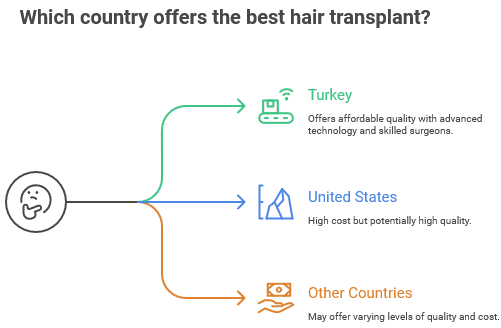If you are dealing with hair loss, you’ve probably looked at some of the options out there. However, it can be difficult to determine which countries have the best and most reliable offers, as you don’t want to invest a lot of time and money only to get mediocre results.
That’s why we will help you find the leading destination for hair transplantation and give you an idea about how much international patients can save compared to getting the surgery in Western countries.
Did you know?
In 2024, more than 1.2 million people worldwide underwent a hair transplant procedure — a 20% increase compared to 2019, according to the International Society of Hair Restoration Surgery (ISHRS). With demand on the rise, patients are increasingly looking for countries that offer excellent results at significantly lower costs.
Factors to Consider When Choosing a Country for Hair Transplant
The top things to look for are the reputation and the size of the medical tourism industry. Chances are that if a lot of people keep coming back every year and there is a lot of online buzz about a location, it has something good to offer.
Look for advanced techniques like Sapphire FUE and DHI, as well as a large number of hair transplant clinics with before and after pictures showing a noticeably thicker and completely natural look.
Best Destinations for Hair Transplants
The main criteria for choosing a good location are a high overall standard of medical care, access to experienced surgeons, and a considerably lower hair transplant cost than in the West. The following countries fit that description perfectly, with some being a bit more viable:
Country | FUE | DHI | Price per graft | Notable feature |
Turkey | $1,500–$4,500 | $2,000–$4,500 | ~$1–$3 | The global leader in quality and price |
Thailand | $2,500–$6,700 | $3,000–$6,400 | ~$1.5–$3.5 | Hair restoration meets paradise vacation |
Hungary | $2,000–$4,000 | $2,000–$4,000 | ~$1.5–$3 | Affordable European quality |
United Kingdom | $3,000–$12,000 | $6,000–$20,000+ | ~$3–$8 | Premium standards and reliable results |
Poland | $2,700–$4,600 | $3,000–$5,000 | ~ $2–$3 | Rising star in global medical tourism |
United States | $8,000–$20,000 | $10,000–$30,000 | ~$3–$6+ | Innovation and excellence |
India | $800–$3,000 | $1,500–$5,000 | ~$0.5–$2 | Cutting-edge methods at low prices |
Spain | $2,900–$5,500 | $3,500–$7,000 | ~$1.5–$3 | Modern clinics in a tourist-friendly destination |
Germany | $3,800–$10,500 | $4,500–$12,000 | ~$2.5–$4 | Famous for precision and expertise |
Mexico | $2,000–$5,000 | $2,500–$6,000 | ~$1–$3 | Accessible for North Americans |
Cheapest Countries for Hair Transplant with Quality Results
If budget is your primary concern, but you still want to get excellent results, it’s best to explore the clinics in Turkey. They feature the latest medical technology, including Robotic surgery, and have a well-developed industry that produces highly skilled surgeons, who also get plenty of practice.
You essentially get really competitive prices, two or three times less than in the United States, without sacrificing any of the quality.
Best Hair Transplant Technology
You want to focus on the latest methods and clinics offering Micro Sapphire DHI and no-shave options, a meticulously controlled process, and even things like Robot-assisted procedures. As the Turkish government offers big tax breaks for clinics involved in medical tourism, you can expect advanced hair transplant surgery at a reasonable price.

How to Prepare for a Hair Transplant Abroad
You will generally need to do some bloodwork and discuss any chronic health issues, allergies, and the medication you are currently using with the doctors at your chosen clinic. You should also stop smoking and drinking alcohol for at least a week prior to the procedure and stop taking blood-thinning medication or eating foods with a similar effect. Your hair transplant surgeon will tell you if there is anything else to consider.
Risks, Safety, and How to Avoid Bad Clinics
The main issues that can arise are infections, bleeding, and underwhelming growth. All of these can be avoided by making a good choice and following the doctor’s advice. Keep an eye out for online reviews on trustworthy platforms, examine the before and after pictures, look for certificates and accreditations, and see if the surgeons are listed on the website.
You Don’t Have to Pay Through the Roof for Excellent Results
While there are a lot of different places offering prices that seem a bit too good to be true, you can rest assured that plenty of them are trustworthy and can offer a high level of care. For now, the quality and cost of a hair transplant in Turkey are still unmatched by any other region, and the all-inclusive packages make traveling a breeze.
FAQs
Which country is best overall for a hair transplant?
Hands down, the top choice is definitely Turkey. It has highly trained surgeons who provide excellent patient care, and the clinics are packed with the latest technology. You will be amazed by the results and have a very pleasant experience at a renowned clinic like Asli Tarcan, and you get post-op support and all the aftercare products you need.
How much does a hair transplant cost in Turkey compared to the USA?
In general, the price per follicular unit is two to three times lower in Turkey. However, when you also consider that some clinics have a fixed price for more extensive operations and use the maximum available grafts, things can be even more affordable than you first thought.
Is it safe to get a hair transplant abroad?
As long as you choose your clinic well, one that is certified and has a good reputation, you don’t have to worry about complications or bad results. A lot of places also offer personal transport between the airport, hotel, and clinic, and book accommodations at the best hotels for you, so you won’t have to deal with scammers or overpriced taxi rides either.
How long does it take to recover after a hair transplant?
You will need around three to five days for the initial swelling, light bleeding, and pain to go away, depending on the method used, and two weeks for the area to fully heal and the scabs to fall off.

